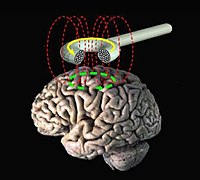
Photo from wikipedia
BRACKGROUND Current treatments for Alzheimer's disease (AD) have a limited clinical response and methods, such as repetitive transcranial magnetic stimulation (rTMS), are being studied as possible treatments for the clinical… Click to show full abstract
BRACKGROUND Current treatments for Alzheimer's disease (AD) have a limited clinical response and methods, such as repetitive transcranial magnetic stimulation (rTMS), are being studied as possible treatments for the clinical symptoms with positive results. However, there is still seldom information on the type of rTMS protocols that deliver the best clinical improvement in AD. Objetive: To compare the clinical response between a simple stimulation protocol on the left dorsolateral prefrontal cortex (lDLPFC) against a complex protocol using six regions of interest. METHODS 19 participants were randomized to receive any of the protocols. The analysis of repeated measures evaluated the change. RESULTS Both protocols were equally proficient at improving cognitive function, behavior and functionality after 3 weeks of treatment, and the effects were maintained for 4 weeks more without treatment. CONCLUSION We suggest rTMS on the lDLPFC could be enough to provide a clinical response, and the underlying mechanisms should be studied.
Journal Title: Brain Stimulation
Year Published: 2018
Link to full text (if available)
Share on Social Media: Sign Up to like & get
recommendations!